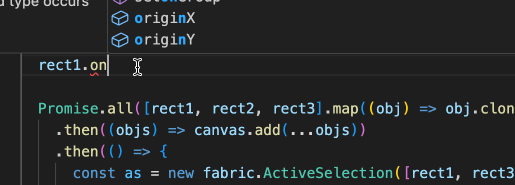Upgrading to Fabric.js 6.0
Fabric 6.0 has been a large rewrite and not all breaking changes have a suggested action items. Not all the desired outcome has been achieved because we were stuck in a long beta stage with frequent breaking changes. This is a list of the largest conceptual changes.
Typescript
Section titled “Typescript”Fabric.js is now written in Typescript. Types will help you discover the api quickly, especially with things like events.
As a consequence of this change if you are using @types/fabric you should remove it.

Imports
Section titled “Imports”Imports changed, we moved from
import { fabric } from 'fabric'to:
import { Canvas, Rect } from 'fabric'and
import { Canvas, Rect } from 'fabric/node'for node usage.
Imports will require some changes in the future again, because the filter and util namespaces are a bit of an issue for tree shaking.
Indeed now you can also do:
import { StaticCanvas, Rect } from 'fabric/es'and import only the parts of fabric you are actually using, but BE AWARE you are not protected for safe usage of loadFromJSON and svg loading, for now use at your own risk and if you are not sure ask informations.
Some classes have been renamed because their name was a reserved keyword
- fabric.Object is now known as FabricObject
- fabric.Text is now known as FabricText
- fabric.Image is now known as FabricImage
Classes vs Functions
Section titled “Classes vs Functions”Before fabric was using functions with agumented prototype and an utility to create inheritance and mixins. That was ok and functional, but didn’t really play well with Typescript.
So before we would have something like this:
function Rect() {
}
Object.assign(Rect.prototype, { strokeWidth: 0, fill: 'black',});The class was created with an utility, createClass that took care of running the custom initialize method for every new instance that was created, and that took care of inheritance.
As a result this was the situation:
- Default values for properties were defined on the prototype exactly as method were
- All Instances shared the same on the prototype for properties that weren’t assigned
- Subclassing required specific fabricjs syntax
- Mixins were possible as simple object merges and were used for code organization and sharing
You could mutate the prototype at runtime to change default values for all classes:
fabric.Object.prototype.originX = 'center';Would have made all instances with originX set to center, apart the ones for which you ever set the origin to some value before changing the prototype. If you were not comfortable with this concept this could have led to unexpected results.
Classes works differently, the syntax does not support default values on the prototype at all, and anyway typescript does not understands it. The setup we picked up for fabricJS main classes is:
- We do not do any prototype mutation by default, but the developer can still opt in for that
- Default values for properties are assigned on the instance as it would be if you are using public properties
- Each class has a mutable static object that holds the default values for that class and that get assigned during the contructor
- There are no more default shared objects between instances for which mutation is tricky ( ex: controls )
- Mixins are there as leftovers, will need to be removed in the future
- Subclassing is done with standard
extendssyntax
class Rect extends FabricObject { _render(ctx) { .... }}Changing default values and getting shared controls is still possible following specific instructions available here:
Callbacks vs Promise
Section titled “Callbacks vs Promise”All the apis that where having a callback with one or parameters are now Promise based.
Everything that was loadSomething(arg, callback, arg2, arg3) is now loadSomething(arg, arg2, arg3).then(callback)
To make an example for loadSVGFromString
loadSVGFromString: function(string, callback, reviver, options) { ... callback(results, _options, elements, allElements);};is now
loadSVGFromString( string: string, reviver?: TSvgReviverCallback, options?: LoadImageOptions).then((result: { objects: (FabricObject | null)[]; options: Record<string, any>; elements: Element[]; allElements: Element[];}) => { ....});Method chaining is deprecated
Section titled “Method chaining is deprecated”If it still works somewhere, don’t use it. It is a leftover.
myRect.set({ fill: 'red' }).rotate(90);is now:
myRect.set({ fill: 'red' });myRect.rotate(90);Lot of breaking changes here and there
Section titled “Lot of breaking changes here and there”There are many breaking changes in Group, in Canvas, in methods signatures and more. If you have a large project with large customizations and subclassing upgrading will be hard, we are sorry about that. There is a more extensive list of changes here: #8299.